GROOTE ESCAPE
By Simon McLean
The score after only five days at Groote Eylandt was more than 400 fish spread over 30 species caught and released, four rods broken and countless stories and memories created.
The invitation was just too good to refuse. Accompany a few boating mates to one of Australia’s top sportsfishing hotspots in late-November and spend five days with a line in the water with more species on our doorstep than you could poke a rod at.
My partners on this particular adventure would be Rob Cuming, CEO of Northbank Boats, Will Sangster, GM of Mercury Marine Asia-Pacific, and Andrew Stephen, dealer principal of Melbourne Marine Centre.
Our destination was Groote Eylandt, Australia’s fourth-largest island, which is situated in the Gulf of Carpentaria, the nearest major population centre being Darwin, 630km to the west.
Named ‘Great Island’ by Dutch explorer Abel Tasman, it has been home to the Anindilyakwa Aboriginal people for hundreds of years. Its main industry these days is manganese mining.
Measuring about 50km east-west and 60km north-south, the island has a varied coastline, from rocky outcrops to remote pristine beaches and mangrove-lined shallows.
But while spending time on the water with good mates chasing some of Australia’s iconic sportsfish is always going to be a great reason to head to the airport, there was one other crucial ingredient.
Fishing legend ‘Bomber’ Farrell is a Groote resident, even holding a few GFAA tag and release records. He also happens to own a high-calibre fishing weapon in the form of a Northbank Danger Pro Series 650 Walkaround. As Bomber had a few spare days up his sleeve, he was more than happy to spend them with some southern visitors keen on exploring the island’s considerable fishing potential.
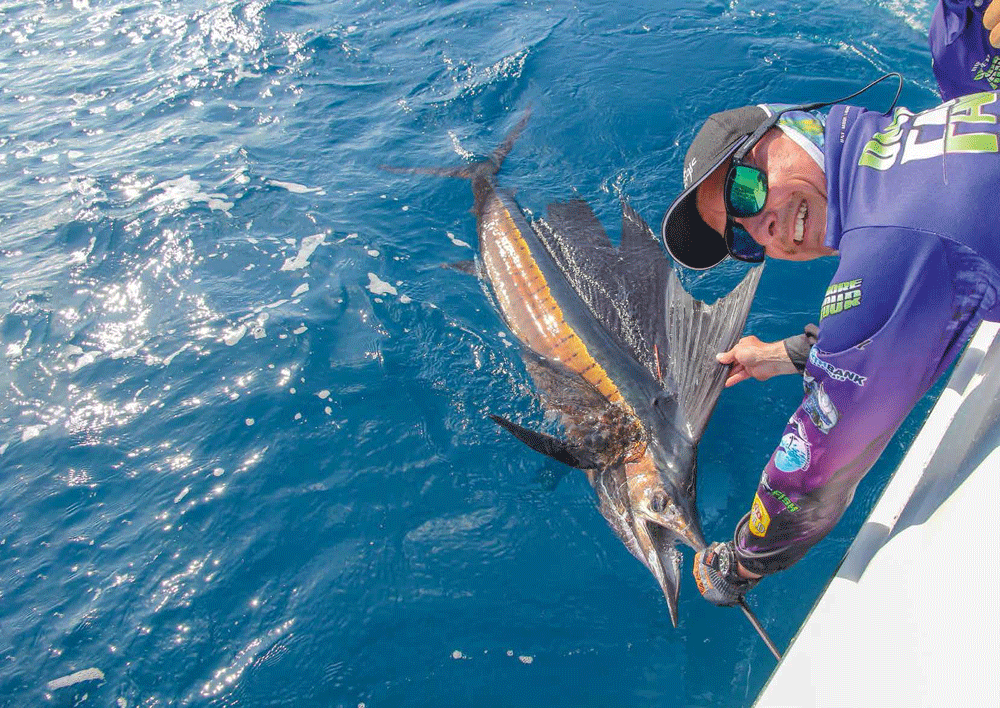
RINGED BY FISH
Actually, as it turned out, pretty much the entire coastline of Groote is one big hotspot and, by the end of the five days aboard Bomber’s rigged-up Northbank, apart from being close to exhaustion from all the fishing, we’d logged up more than 30 species caught, along with a few rods that had succumbed to the punishment.
It’s hard to know where to start when it comes to covering the highlights of our Groote adventure, whether it was our time on the water exploring the incredible coastline and local waters, the abundant marine life and, of course, the spectacular fishing.
We all had some idea of what lay in store from talking to some fishing identities about Groote’s reputation for the nature and number of its sportsfishing opportunities, and our first night on the island was spent with Bomber going over the logistics and schedule for the trip and talking about what we’d be catching and how. Interestingly, apart from the livies we’d be using on sailfish, bait was off the menu for this trip. Instead, we’d be using soft plastics, hard-body stick baits and poppers to target local species.
The first morning dawned hot and humid and Bomber ensured we were on the water early to make the most of the fishing that lay ahead. We launched at the main boat ramp at Alyangula, in sight of the large manganese loading facility in the main harbour, and were soon on our way, armed with a veritable arsenal of lures, rods and all the gear needed to stay on the water for the next few days. The plan was to stay out to maximise our fishing time, sleeping rough on the land or in the boat, depending on where we ended each day.
We’d partially circumnavigate the island for the first three days in a clockwise direction, checking in at various hotspots along the way based on Bomber’s extensive knowledge of the local waters.
Trevally seemed to be everywhere as we headed north. In fact, it wasn’t until I was hooked up to my fourth straight trevally in the space of 15 minutes that I realised how prolific the sportsfishing is on this isolated island. For the remaining four days, my companions and I would experience what might well become, at least in my case, the ultimate sportsfishing adventure.
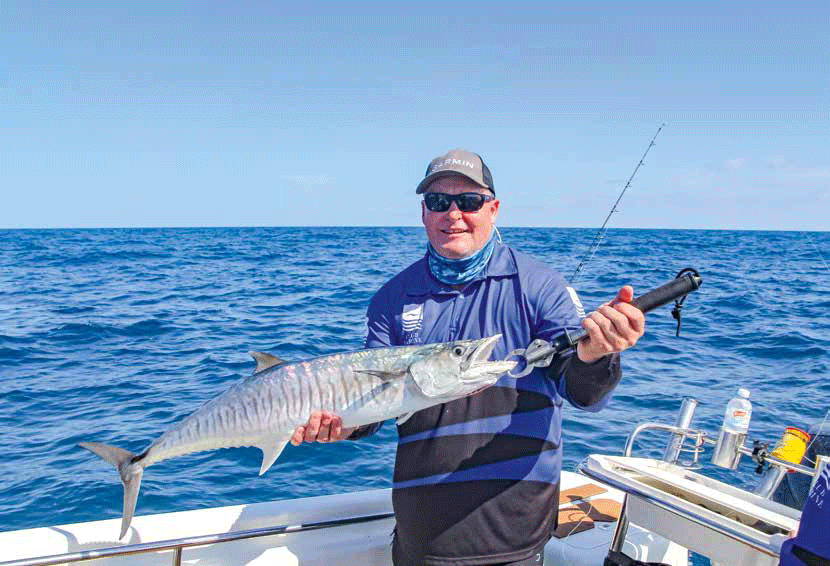
SHARK ATTACK
One of the really amazing experiences of the trip was my encounter with a particularly spirited trevally. As I got it close to the boat, it became apparent that the fish had more to worry about than the hook embedded in its bony mouth. Just as we prepared to land it, out from the clear water leapt a decent-sized shark, which disappeared just as quickly with most of my fish in its mouth, spraying blood all over the big Mercury Verado as it claimed its prize. It was a sobering reminder that we were in a very wild place where nature ruled – and didn’t take kindly to outsiders who flouted the rules.
Other highlights, apart from being hammered all day by trevally and queenfish, was the boating of a rare and very pretty giant herring, along with the curiously named tricky snapper, red emperor and coral trout, one of which made it onto the fire for that evening’s exquisite meal, enjoyed in the quiet seclusion of a hidden bay before we retired to sleep on the boat for the night.
Our destination for day two was the unfortunately named Rats Cove, on the small island of Bickerton, about 50km north of Alyangula. The cove’s name does no justice to its beautiful sandy beach and pristine surrounds, and it made for a spectacular campsite for our second night out.
Prior to our arrival, we notched up some impressive hook-ups, employing a number of techniques to get the better of our local piscatorial protagonists and resulting in a pretty good session on coral trout trolling poppers over the bommies, with Bomber scoring an excellent 69cm specimen.
Other standout fish for the day included a muscular cobia, large-mouth nannygai, Spanish mackerel and some industrial-sized estuary cod.

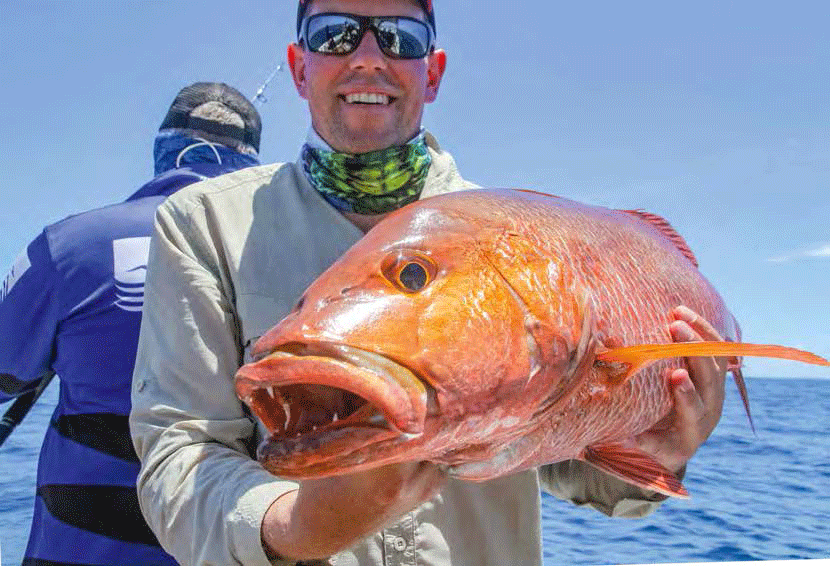
CANNIBAL CUDA
We had another reminder of the savagery that can be meted out to the unwitting after we brought a barracuda to the boat and then released it to continue on its way – or so we thought. Just as it looked like it was ready to head back to the deep, another ’cuda swam up and cut it in half with its powerful razor-lined jaws.
Equally impressive was a quintuple hook-up on queenies, with Bomber managing the chaos expertly. It was every man and rod for himself, but ultimately we managed to bring the fish to the boat and free them all to fight another day.
Our third day on the northern side of Groote was spent exploring the coast and, in particular, the extensive mangrove systems where we had plenty of action at Crackerjack Bay casting for mangrove jacks. And everywhere we went it seemed the water teemed with trevally and queenies. I was fortunate to land a PB trevally on light gear, while flicking lures for mangrove jacks, and we saw an indication of the voracious appetite of the locals when Bomber explained that you don’t even need a lure or bait to catch fish at Groote. In disbelief, I took up the challenge and cast a bare hook near a school of queenfish and, with Bomber coaching, wound like crazy.
Before I knew it, I was on and managed to score my first queenie with nothing but a hook. And just to prove it wasn’t a fluke, my next cast was rewarded by another queenie, followed by a trevally. What a place!
That evening, we returned to the sheltered cove we’d enjoyed on our first night out, only this time around we elected to sleep under the stars on the beach rather than on the boat. Bomber cautioned that we might be in for a rude – and deadly – awakening, though, if one of the local salties happened to be looking for a late-night snack. Needless to say, we made sure there was plenty of distance between our campsite and the water for the night.
On the way back to Alyangula we had a cultural interlude, with Bomber taking us to a remote aboriginal site to view some ancient rock art. It was a reminder that the area has been inhabited for eons and is full of indigenous history.
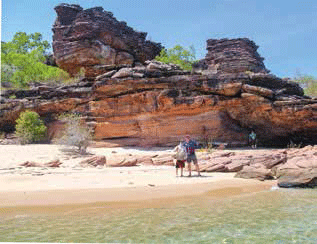
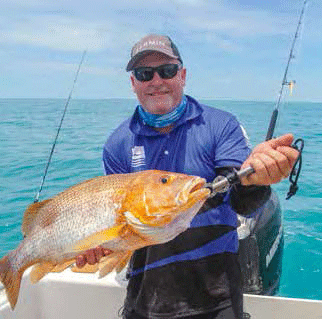
SAIL CENTRAL
Our second-last day on the water was action-packed – and for me a real highpoint of the trip. The destination was an area off the south-eastern tip of the island where sailfish congregate. Anyone who has hooked a sail will know what a spectacular fighting fish they are and they certainly didn’t disappoint on our visit.
Once we reached the fishing grounds, we got busy filling the livewell with local bait species, including pilchards and sardines, while Bomber briefed us on tactics for the day.
The plan was to ‘switch bait’ by towing a spread of teasers and baits without hooks to begin with, waiting for any sign of sail activity. Once we had fish in the spread the idea was to slip a rigged-up livebait into the strike zone and wait for the fish to take notice. And boy, once they got a whiff of the livie, it didn’t take long before the reels were going off. The main thing was to let the line free-spool to begin with so the fish consumed the bait and hook completely, and then rely on the circle hook to set in the jaw once the reel was on strike.
As Bomber revealed, the southern waters of Groote attract some of the biggest and most athletic sailfish in Australian waters and the three fish we caught on the day certainly didn’t disappoint.
Our last day was spent focusing on golden snapper, a delicious eating fish. We reached Bomber’s chosen spot and right on time the fish showed up too. Within seconds of dropping our lines, we had fish on – a simultaneous quad hook-up, with two golden snapper, one coral trout and a trevally.
We eventually bagged out on the golden snapper, our haul being used to good effect by several locals that evening.
With bags to pack and planes to catch, we had to call it quits earlier than we’d have liked, but after such an incredible adventure, and with arms aching from some serious fishing action, it was time to head back to Groote.
The only species I didn’t come to grips with over the five days was barramundi, but Rob and Andrew made up for my lapse. They stayed over an extra couple of days and hooked up to an incredible 60 fish over two action-packed sessions on one of the mainland tidal rivers that run into Blue Mud Bay, including a personal best 97cm specimen for Rob.
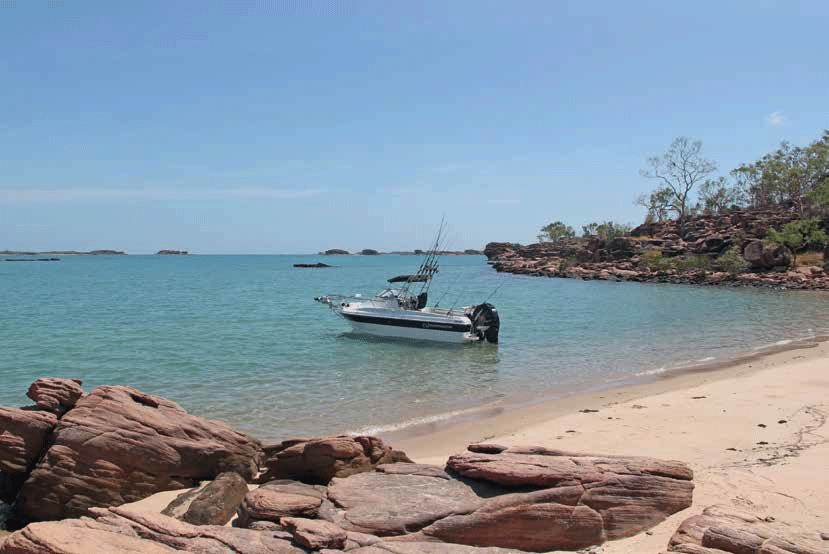
Speaking for the entire crew, our time with Bomber will certainly go down as one of our all-time great fishing experiences. It seemed we only had to drop a line in the water and the fish were queued up to jump on and give us a memorable battle. Groote Eylandt, and in particular its spectacular and varied coastline, is worth a visit in its own right, and time and again the Northbank Danger Pro 650 Walkaround proved its worth as an extremely competent, safe and well thought out fishing platform.
If you’re looking for a truly amazing sportsfishing experience, do yourself a favour, head for Groote Eylandt.




